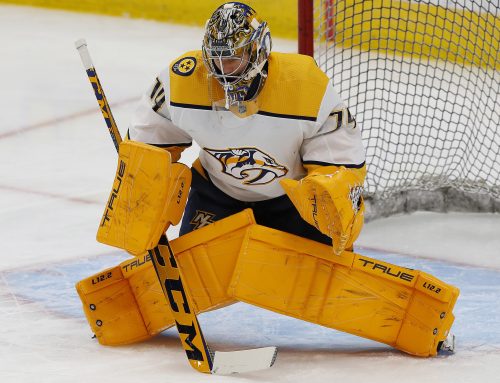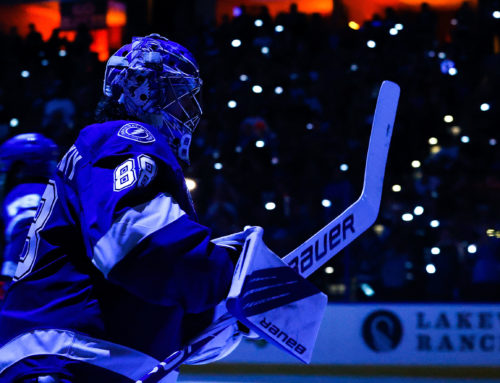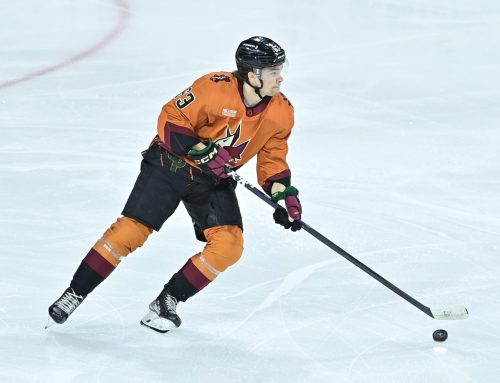Unlocking the Future of Fantasy Hockey with NHL Equivalency and Player Tracking Technology
Stas Pupkov
2023-09-07
The world of fantasy hockey is heavily driven by data and statistical analysis, including traditional metrics such as Zone Start Percentage (ZS%) and Corsi-For Percentage (CF%), standard tools that have been in use since the early to late 2000s. As time has passed and technology has advanced, new frontiers in analytics have emerged, with cutting-edge metrics like NHL Equivalency (NHLe) and Player Tracking Technology leading the way. These innovative tools remain commonly underexplored but hold significant potential for reshaping our understanding of the game. This article attempts to shed light on these exciting developments, illuminating their significance and potential application within the context of fantasy hockey. By digging into these new and thrilling statistical indicators, we aim to provide readers with a comprehensive understanding that extends beyond conventional use, and with any luck, giving you the edge in your fantasy hockey league.
NHLe
NHL Equivalency (NHLe) is a metric which measures a player's scoring rate from a non-NHL league, and then translates that scoring rate into an NHL equivalent scoring rate. Mainly used for prospects and rookies, it helps provide a measuring stick to allow for the comparison of players from different leagues. To derive the formula for NHLe there needs to be a league quality coefficient, which can be calculated by taking all the players who spend at least one year in a league outside of the NHL, along with the players performance in year 2 of NHL action. To calculate the League Quality (LQ) for a specific league(X) using the formula:
LQX = PPG in NHLYear 2 / PPG in LeagueX Year1
Given the league quality, it is then possible to calculate a player's NHLe,
NHLe = (PPG in Leaguex ) / ( Games Played in Leaguex) ) x LQx
The applications of NHLe can be compare different players across different leagues, for example, Elias Pettersson is a player who played incredibly well in his draft year+1, which we will be using in the calculation.
Pettersson's NHLe = (56/44 = 1.27) X 0.6 (LQx) = 1.27 X 0.6 = 0.762
Once you find the NHLe, to find the PPG per 82 games, it just takes NHLe * 82 = NHLe per 82(Season), so given Pettersson's 0.762 , his NHLe per season can be found as
0.762 * 82 = 62.484, rounded to 62
So, in his draft+1 year, Elias Pettersson could be expected to put up around 62pts in the NHL in 82 games.
Fantasy Hockey Applications
In the competitive realm of fantasy hockey, where every point counts and the stakes are high, NHLe serves as a valuable tool for managers seeking an edge. By translating a player’s scoring rate from various non-NHL leagues into an NHL equivalent, NHLe provides a common measuring stick, allowing for the comparison of prospects and rookies across different leagues. This can be particularly useful during draft season, where identifying the next breakout star can make or break a fantasy season. For example, a fantasy manager considering drafting a European player can use NHLe to gauge how that player’s performance might translate to the NHL. By comparing NHLe values, managers can make more informed decisions, selecting players with the potential to outperform their draft position.
Limitations of NHLe
While NHLe offers valuable insights, it’s essential to recognize its limitations and apply it with caution. Here are some key areas to consider:
League Quality Variability: The league quality coefficient (LQ) is central to the NHLe calculation, but it can vary based on different methodologies and updated research. A slight change in the LQ can significantly impact the NHLe value, leading to potential inaccuracies.
Positional and Situational Factors: NHLe primarily focuses on scoring rate, but it does not account for positional differences, playing time, linemates, or specific roles within a team. These factors can influence a player’s NHL performance in ways that NHLe may not capture.
Age Consideration: Age can be a significant factor in player development, especially for prospects and rookies. NHLe doesn’t inherently account for age, which can lead to skewed comparisons between players at different stages of their careers.
Not a One-Size-Fits-All Metric: While NHLe provides a standardized measure, it may not be equally applicable to all players or leagues. Some players may outperform or underperform their NHLe values, and relying solely on this metric may overlook other essential aspects of player evaluation.
The Evolving Landscape of Hockey Analytics
NHL Equivalency (NHLe) has indeed paved the way for new insights in player evaluation, but it represents merely the beginning in the fast-paced advancement of hockey analytics. As technology and data science continue to intertwine with the sport, a host of more refined tools are emerging, revolutionizing our comprehension of hockey. Whether it’s the real-time tracking of players’ movements on the ice, the future of hockey analytics is unfolding before our eyes.
An innovation like Player Tracking Technology is not only enhancing the way teams and analysts evaluate performance but also providing fantasy hockey managers with unprecedented insights. These cutting-edge tools offer a deeper look into player abilities, potential, and trends, going beyond traditional metrics to uncover hidden layers of the game.
Player Tracking Technology(PTT)
Ever since the NHL decided to follow through with plans to adopt a system that collects unprecedented forms of data, Puck and Player Tracking Technology has been a game-changer. Now installed in every single NHL arena, this technology allows for the gathering of metrics like player position, puck position, speed, direction, pass success, faceoff probability, and more. It represents a new frontier in hockey analytics, offering insights and opportunities that were previously beyond reach. The integration of PTT in the NHL represents a significant advancement in the sport’s analytical capabilities. Utilizing multiple cameras placed strategically in the arenas, the system receives and updates data at a rate of 25 frames per second. This data is then fed into proprietary software, where computer vision algorithms extract positional data for all players on the ice and the puck itself.
Key Metrics and Applications
The introduction of PTT has led to a plethora of new statistics that are now available to teams, broadcasters, and fans. Some of the key statistics collected include:
Player Speed and Acceleration: Measures the speed of players on the ice, including top speed, average speed, and acceleration patterns.
Puck Trajectory and Speed: Tracks the puck’s movement, including its speed, direction, and height off the ice.
Passing Analysis: Analyzes the success rate of passes, pass direction, and the speed of passes.
Zone Entries and Exits: Monitors how players enter and exit offensive and defensive zones, providing insights into team strategy and player decision-making.
Faceoff Success: Breaks down faceoff wins and losses, including player positioning and puck control.
Shot Analysis: Includes details on shot speed, angle, and success rate, providing a comprehensive view of shooting performance.
Time on Ice and Shift Details: Monitors player shifts, including time on ice, rest periods, and shift effectiveness.
Impact on Fantasy Hockey
For fantasy hockey managers, PTT offers a new layer of insights that can be leveraged to gain a competitive edge. The detailed analysis of player movements, puck control, and game strategy provides a deeper understanding of player potential and performance. Whether it’s identifying undervalued players or predicting breakout stars, PTT adds a new dimension to fantasy hockey decision-making.
Limitations of Player Tracking Technology (PTT)
While PTT offers groundbreaking insights, it is crucial to recognize its limitations and apply it discerningly. Here are some key areas to consider:
Accuracy Concerns: Precision in tracking is vital, and any errors or inconsistencies can lead to misleading or incorrect data, affecting evaluations and decisions.
Data Overload: The sheer volume of information generated by PTT requires sophisticated analysis and interpretation. Without expert handling, the data can become overwhelming and less actionable.
Technology Uniformity: Differences in equipment or inconsistencies in technology across arenas can affect the quality and comparability of the data collected.
Privacy Issues: The collection of detailed player data raises ethical considerations around privacy and the handling of sensitive information. Ensuring responsible use is paramount.
These considerations highlight the need for careful application and interpretation of PTT, recognizing both its potential and its challenges.
Recap
In the ever-evolving world of fantasy hockey, traditional metrics have given way to innovative tools like NHL Equivalency (NHLe) and Player Tracking Technology (PTT). These advancements are reshaping our understanding of the game, providing unprecedented insights into player performance and potential. NHLe allows for the comparison of players across different leagues, translating scoring rates into NHL equivalents. PTT allows for real-time tracking of players’ movements, puck position, speed, and more. These tools provide incredible amounts of value, but it is crucial to recognize their limitations, such as accuracy concerns, data overload, and privacy issues. The integration of these technologies represents a significant advancement in hockey analytics, opening new doors for fantasy hockey managers. The world of fantasy hockey is no longer confined to mere statistics and gut feelings. It is a dynamic and exciting field that demands a keen understanding of the latest tools and technologies. As a fantasy hockey manager, are you ready to embrace the future? Dive into the world of NHLe and PTT, get to know their uses, and elevate your fantasy hockey game. The future of the sport is exciting and ripe for exploration, and it is all there for you to grab hold of. Equip yourself with the knowledge, embrace the innovation, and lead your league to victory. The game is changing; are you?
One Comment
Leave A Comment
You must be logged in to post a comment.




 BOS
BOS TOR
TOR CAR
CAR NYI
NYI WPG
WPG COL
COL VAN
VAN NSH
NSH DAL
DAL T.B
T.B FLA
FLA VGK
VGK PIT
PIT N.J
N.J

Where do you find the LQx for each league?